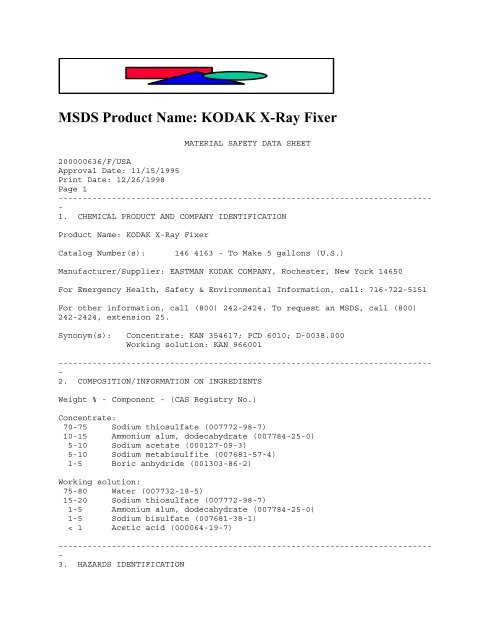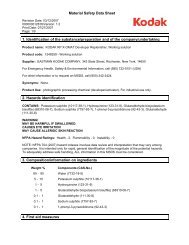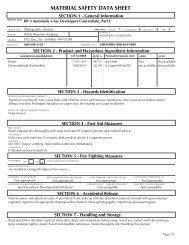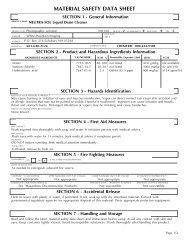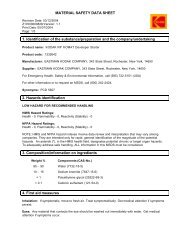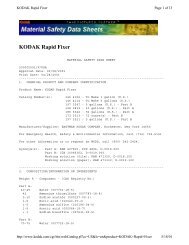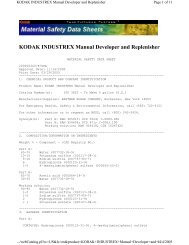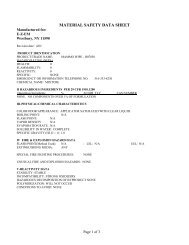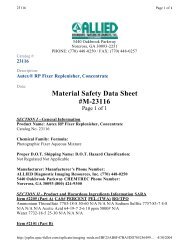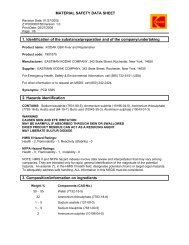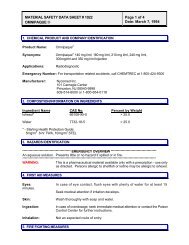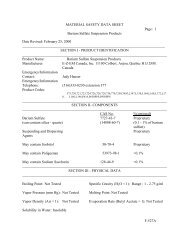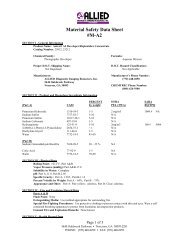MSDS Product Name: KODAK X-Ray Fixer
MSDS Product Name: KODAK X-Ray Fixer
MSDS Product Name: KODAK X-Ray Fixer
Create successful ePaper yourself
Turn your PDF publications into a flip-book with our unique Google optimized e-Paper software.
<strong>MSDS</strong> <strong>Product</strong> <strong>Name</strong>: <strong>KODAK</strong> X-<strong>Ray</strong> <strong>Fixer</strong><br />
MATERIAL SAFETY DATA SHEET<br />
200000636/F/USA<br />
Approval Date: 11/15/1995<br />
Print Date: 12/26/1998<br />
Page 1<br />
-----------------------------------------------------------------------------<br />
-<br />
1. CHEMICAL PRODUCT AND COMPANY IDENTIFICATION<br />
<strong>Product</strong> <strong>Name</strong>: <strong>KODAK</strong> X-<strong>Ray</strong> <strong>Fixer</strong><br />
Catalog Number(s):<br />
146 4163 - To Make 5 gallons (U.S.)<br />
Manufacturer/Supplier: EASTMAN <strong>KODAK</strong> COMPANY, Rochester, New York 14650<br />
For Emergency Health, Safety & Environmental Information, call: 716-722-5151<br />
For other information, call (800) 242-2424. To request an <strong>MSDS</strong>, call (800)<br />
242-2424, extension 25.<br />
Synonym(s): Concentrate: KAN 354617; PCD 6010; D-0038.000<br />
Working solution: KAN 966001<br />
-----------------------------------------------------------------------------<br />
-<br />
2. COMPOSITION/INFORMATION ON INGREDIENTS<br />
Weight % - Component - (CAS Registry No.)<br />
Concentrate:<br />
70-75 Sodium thiosulfate (007772-98-7)<br />
10-15 Ammonium alum, dodecahydrate (007784-25-0)<br />
5-10 Sodium acetate (000127-09-3)<br />
5-10 Sodium metabisulfite (007681-57-4)<br />
1-5 Boric anhydride (001303-86-2)<br />
Working solution:<br />
75-80 Water (007732-18-5)<br />
15-20 Sodium thiosulfate (007772-98-7)<br />
1-5 Ammonium alum, dodecahydrate (007784-25-0)<br />
1-5 Sodium bisulfate (007681-38-1)<br />
< 1 Acetic acid (000064-19-7)<br />
-----------------------------------------------------------------------------<br />
-<br />
3. HAZARDS IDENTIFICATION
Concentrate:<br />
WARNING! REDUCING AGENT<br />
POWDERED MATERIAL MAY FORM EXPLOSIVE DUST-AIR MIXTURES<br />
HMIS Hazard Ratings:<br />
Health - 0, Flammability - 1, Reactivity - 0, Personal Protection - B<br />
NFPA Hazard Ratings:<br />
Health - 1, Flammability - 1, Reactivity (Stability) - 0<br />
Working solution:<br />
LOW HAZARD FOR RECOMMENDED HANDLING<br />
HMIS Hazard Ratings:<br />
Health - 0, Flammability - 1, Reactivity - 0, Personal Protection - B<br />
NFPA Hazard Ratings:<br />
Health - 1, Flammability - 1, Reactivity (Stability) - 0<br />
NOTE: HMIS and NFPA hazard indexes involve data review and interpretation<br />
that<br />
may vary among companies. They are intended only for rapid, general<br />
identification of the magnitude of the potential hazards. The personal<br />
protection index is only intended for general guidance on personal protection<br />
equipment (PPE) that is suitable for the potential hazards of the material.<br />
PPE (e.g., respirators) may not be needed if engineering controls (e.g.,<br />
local<br />
ventilation) are adequate. To adequately address safe handling, ALL<br />
information in this <strong>MSDS</strong> must be considered.<br />
-----------------------------------------------------------------------------<br />
-<br />
4. FIRST-AID MEASURES<br />
Inhalation: If symptomatic, move to fresh air. Get medical attention if<br />
symptoms persist.<br />
Eyes: Any material that contacts the eye should be washed out immediately<br />
with<br />
water. Get medical attention if symptoms occur.<br />
Skin: Wash with soap and water. Get medical attention if symptoms occur.<br />
Ingestion: Drink 1-2 glasses of water. Seek medical attention.<br />
-----------------------------------------------------------------------------<br />
-<br />
5. FIRE FIGHTING MEASURES<br />
Extinguishing Media:<br />
Concentrate: Water spray, carbon dioxide (CO2), dry chemical<br />
Working solution: Water spray, carbon dioxide (CO2), dry chemical, alcohol<br />
foam
Special Fire-Fighting Procedures: Wear self-contained breathing apparatus and<br />
protective clothing. Fire or excessive heat may produce hazardous<br />
decomposition products.<br />
Hazardous Combustion <strong>Product</strong>s:<br />
Concentrate: Carbon dioxide, carbon monoxide, oxides of sulfur, oxides of<br />
nitrogen, (see also Hazardous Decomposition <strong>Product</strong>s section)<br />
Working solution: Oxides of nitrogen, carbon dioxide, carbon monoxide,<br />
oxides of sulfur, (see also Hazardous Decomposition <strong>Product</strong>s section)<br />
Unusual Fire and Explosion Hazards:<br />
Concentrate: Powdered material may form explosive dust-air mixtures.<br />
Reducing agent. Greatly increases the burning rate of combustible<br />
materials.<br />
Working solution: Dried product residue can act as a reducing agent.<br />
-----------------------------------------------------------------------------<br />
-<br />
6. ACCIDENTAL RELEASE MEASURES<br />
Concentrate: Flush to sewer with large amounts of water. Clean surface<br />
thoroughly to remove residual contamination.<br />
Working solution: Flush to sewer with large amounts of water. Otherwise,<br />
absorb spill with vermiculite or other inert material, then place in a<br />
container for chemical waste. Clean surface thoroughly to remove residual<br />
contamination.<br />
-----------------------------------------------------------------------------<br />
-<br />
7. HANDLING AND STORAGE<br />
Personal Precautionary Measures: Avoid breathing dust. Avoid prolonged or<br />
repeated contact with skin. Use with adequate ventilation. Wash thoroughly<br />
after handling.<br />
Prevention of Fire and Explosion:<br />
Concentrate: Keep from contact with oxidizing materials, highly oxygenated<br />
or halogenated solvents, organic compounds containing reducible functional<br />
groups, or aqueous ammonia. Refer to NFPA Pamphlet No. 654, "Prevention of<br />
Fire and Dust Explosions in the Chemical, Dye, Pharmaceutical, and Plastics<br />
Industries." Minimize dust generation and accumulation. Use with adequate<br />
ventilation. Keep away from combustible material. Remove and wash<br />
contaminated clothing promptly.<br />
Working solution: Keep from contact with oxidizing materials.<br />
Storage:<br />
Concentrate: Keep container tightly closed. Keep away from incompatible<br />
substances (see Incompatibility section). Do not store or ship together<br />
with
combustible material. Store in original container.<br />
Working solution: Keep container tightly closed. Keep away from<br />
incompatible<br />
substances (see Incompatibility section).<br />
-----------------------------------------------------------------------------<br />
-<br />
8. EXPOSURE CONTROLS/PERSONAL PROTECTION<br />
Exposure Limits:<br />
ACGIH Threshold Limit Value (TLV):<br />
Boric anhydride: 10 mg/m3 TWA<br />
Sodium metabisulfite: 5 mg/m3 TWA<br />
Sodium bisulfite: 5 mg/m3 TWA<br />
OSHA (USA) Permissible Exposure Limit (PEL - 1971 Table Z-1 Values): Not<br />
established<br />
Ventilation: Good general ventilation (typically 10 air changes per hour)<br />
should be used. Ventilation rates should be matched to conditions. If<br />
engineering controls do not maintain airborne concentrations below<br />
recommended<br />
exposure limits, an approved respirator must be worn. Respirator type: Dust,<br />
acid gas. If respirators are used, a program should be instituted to assure<br />
compliance with OSHA Standard 29 CFR 1910.134.<br />
Respiratory Protection: None should be needed.<br />
Eye Protection: It is a good industrial hygiene practice to minimize eye<br />
contact. Wear safety glasses with side shields (or goggles).<br />
Skin Protection: It is a good industrial hygiene practice to minimize skin<br />
contact. For operations where prolonged or repeated skin contact may occur,<br />
impervious gloves should be worn.<br />
Recommended Decontamination Facilities: Eye bath, washing facilities, safety<br />
shower<br />
-----------------------------------------------------------------------------<br />
-<br />
9. PHYSICAL AND CHEMICAL PROPERTIES<br />
Physical Form:<br />
Concentrate: Solid (powder)<br />
Working solution: Liquid<br />
Color:<br />
Concentrate: White<br />
Working solution: Colorless<br />
Odor: Odorless<br />
Specific Gravity (water = 1):<br />
Concentrate: Not available<br />
Working solution: > 1.00<br />
Vapor Pressure at 20°C (68°F):<br />
Concentrate: Negligible<br />
Working solution: 24 mbar (18 mm Hg)
Vapor Density (Air = 1):<br />
Concentrate: Not applicable<br />
Working solution: 0.6<br />
Volatile Fraction by Weight:<br />
Concentrate: Negligible<br />
Working solution: 80-85%<br />
Boiling Point:<br />
Concentrate: Not applicable<br />
Working solution: >100°C (>212°F)<br />
Melting Point:<br />
Concentrate: Not available<br />
Working solution: Not applicable<br />
Solubility in Water:<br />
Concentrate: Appreciable<br />
Working solution: Complete<br />
pH:<br />
Concentrate: Not applicable<br />
Working solution: 4.2-4.6<br />
Flash Point:<br />
Concentrate: Not applicable, combustible solid<br />
Working solution: None<br />
-----------------------------------------------------------------------------<br />
-<br />
10. STABILITY AND REACTIVITY<br />
Stability: Stable<br />
Incompatibility:<br />
Concentrate: Strong oxidizing agents, bases, sodium hypochlorite (bleach),<br />
combustible material, halogenated materials, strong acids.<br />
Working solution: Strong oxidizing agents, strong acids, bases, sodium<br />
hypochlorite (bleach).<br />
Hazardous Decomposition <strong>Product</strong>s: Ammonia, chloramine<br />
Hazardous Polymerization: Will not occur.<br />
-----------------------------------------------------------------------------<br />
-<br />
11. TOXICOLOGICAL INFORMATION<br />
Effects of Exposure:<br />
Inhalation: Expected to be a low hazard for recommended handling. In<br />
contact<br />
with strong acids or if heated, sulfites may liberate sulfur dioxide gas.<br />
Sulfur dioxide gas is irritating to the respiratory tract. Some asthmatics<br />
or hypersensitive individuals may experience difficult breathing.<br />
Eyes: No specific hazard known. May cause transient irritation.<br />
Skin: Low hazard for recommended handling.<br />
Ingestion: Expected to be a low ingestion hazard. Some asthmatics or<br />
sulfite-sensitive individuals may experience wheezing, chest tightness,
stomach upset, hives, faintness, weakness and diarrhea.<br />
-----------------------------------------------------------------------------<br />
-<br />
12. ECOLOGICAL INFORMATION<br />
Introduction: This environmental effects summary is written to assist in<br />
addressing emergencies created by an accidental spill which might occur<br />
during<br />
the shipment of this material, and, in general, it is not meant to address<br />
discharges to sanitary sewers or publically owned treatment works.<br />
Summary: Data for the major components of this material have been used to<br />
estimate the environmental impact of this material. This material forms a<br />
moderately acidic aqueous solution, and this property may cause adverse<br />
environmental effects. However, this material, itself, has not been tested<br />
for<br />
environmental effects.<br />
It is expected to have the following properties: a moderate biochemical<br />
oxygen<br />
demand and may cause oxygen depletion in aqueous systems, a low potential to<br />
affect aquatic organisms, a low potential to affect secondary waste treatment<br />
microbial metabolism, a low potential to affect the germination and/or early<br />
growth of some plants, a low potential to bioconcentrate. When diluted with a<br />
large amount of water, this material released directly or indirectly into the<br />
environment is not expected to have a significant impact.<br />
-----------------------------------------------------------------------------<br />
-<br />
13. DISPOSAL CONSIDERATIONS<br />
Concentrate: Since emptied containers retain product residue, follow label<br />
warnings even after container is emptied.<br />
Working solution: Discharge, treatment, or disposal may be subject to<br />
national, state, or local laws. Flush to sewer with large amounts of water.<br />
-----------------------------------------------------------------------------<br />
-<br />
14. TRANSPORT INFORMATION<br />
- For transportation information regarding this product, call the Kodak<br />
Information Center: (800) 242-2424 between 8 a.m. and 8 p.m. (Eastern<br />
Standard Time), Monday through Friday.<br />
-----------------------------------------------------------------------------<br />
-<br />
15. REGULATORY INFORMATION<br />
- Material(s) known to the State of California to cause cancer: None<br />
- Material(s) known to the State of California to cause adverse reproductive<br />
effects: None<br />
- Carcinogenicity Classification (components present at 0.1% or more):<br />
- International Agency for Research on Cancer (IARC): None<br />
- American Conference of Governmental Industrial Hygienists (ACGIH): None
- National Toxicology Program (NTP): None<br />
- Occupational Safety and Health Administration (OSHA): None<br />
- Chemical(s) subject to the reporting requirements of Section 313 or Title<br />
III of the Superfund Amendments and Reauthorization Act (SARA) of 1986 and<br />
40 CFR Part 372: None<br />
-----------------------------------------------------------------------------<br />
-<br />
16. OTHER INFORMATION<br />
US/Canadian Label Statements:<br />
Concentrate:<br />
WARNING! REDUCING AGENT<br />
POWDERED MATERIAL MAY FORM EXPLOSIVE DUST-AIR MIXTURES<br />
Avoid breathing dust.<br />
Avoid prolonged or repeated contact with skin.<br />
Keep container tightly closed.<br />
Minimize dust generation and accumulation.<br />
Use only with adequate ventilation.<br />
Keep from contact with clothing and other combustible materials. Remove<br />
and wash contaminated clothing promptly.<br />
IN CASE OF FIRE: Use water spray, carbon dioxide (CO2), dry chemical<br />
Keep out of reach of children.<br />
For additional information, see Material Safety Data Sheet (<strong>MSDS</strong>) for<br />
this<br />
material.<br />
Since emptied containers retain product residue, follow label warnings<br />
even after container is emptied.<br />
Working solution:<br />
LOW HAZARD FOR RECOMMENDED HANDLING<br />
Keep out of reach of children.<br />
For additional information, see Material Safety Data Sheet (<strong>MSDS</strong>) for<br />
this<br />
material.<br />
Additional hazard precautions for containers greater than 1 gallon of<br />
liquid or 5 pounds of solid:<br />
IN CASE OF FIRE: Use water spray, carbon dioxide (CO2), dry chemical,<br />
alcohol foam<br />
-----------------------------------------------------------------------------<br />
-<br />
The information contained herein is furnished without warranty of any kind.<br />
Users should consider these data only as a supplement to other information
gathered by them and must make independent determinations of suitability and<br />
completeness of information from all sources to assure proper use and<br />
disposal<br />
of these materials and the safety and health of employees and customers and<br />
the protection of the environment.<br />
Home | Find | <strong>Product</strong>s | Support |<br />
Shop | Member Services |<br />
Contact webmaster if this site<br />
presents any problems.<br />
Copyright © Eastman Kodak Company, 1994-1999 and<br />
Privacy Practices.


